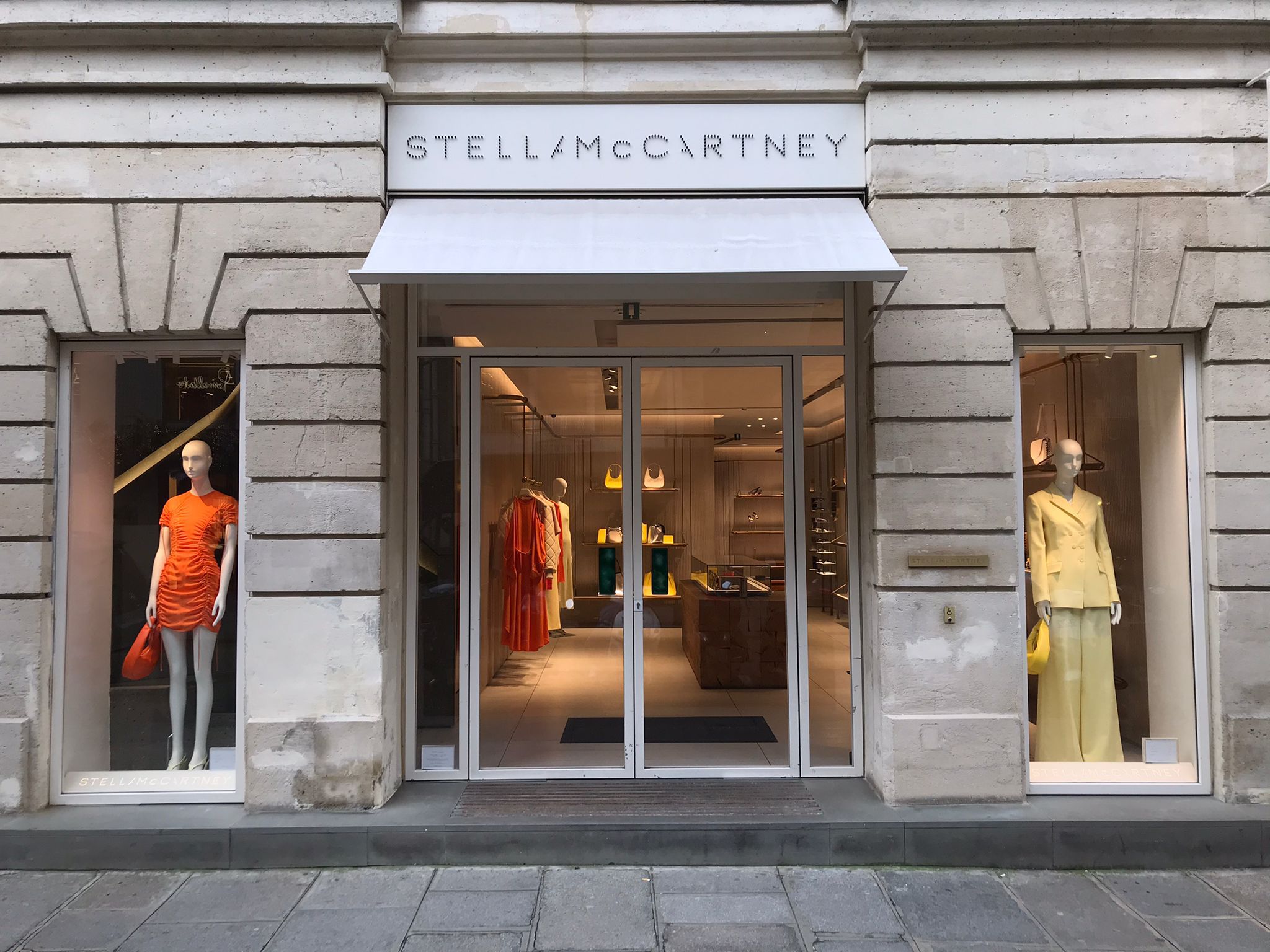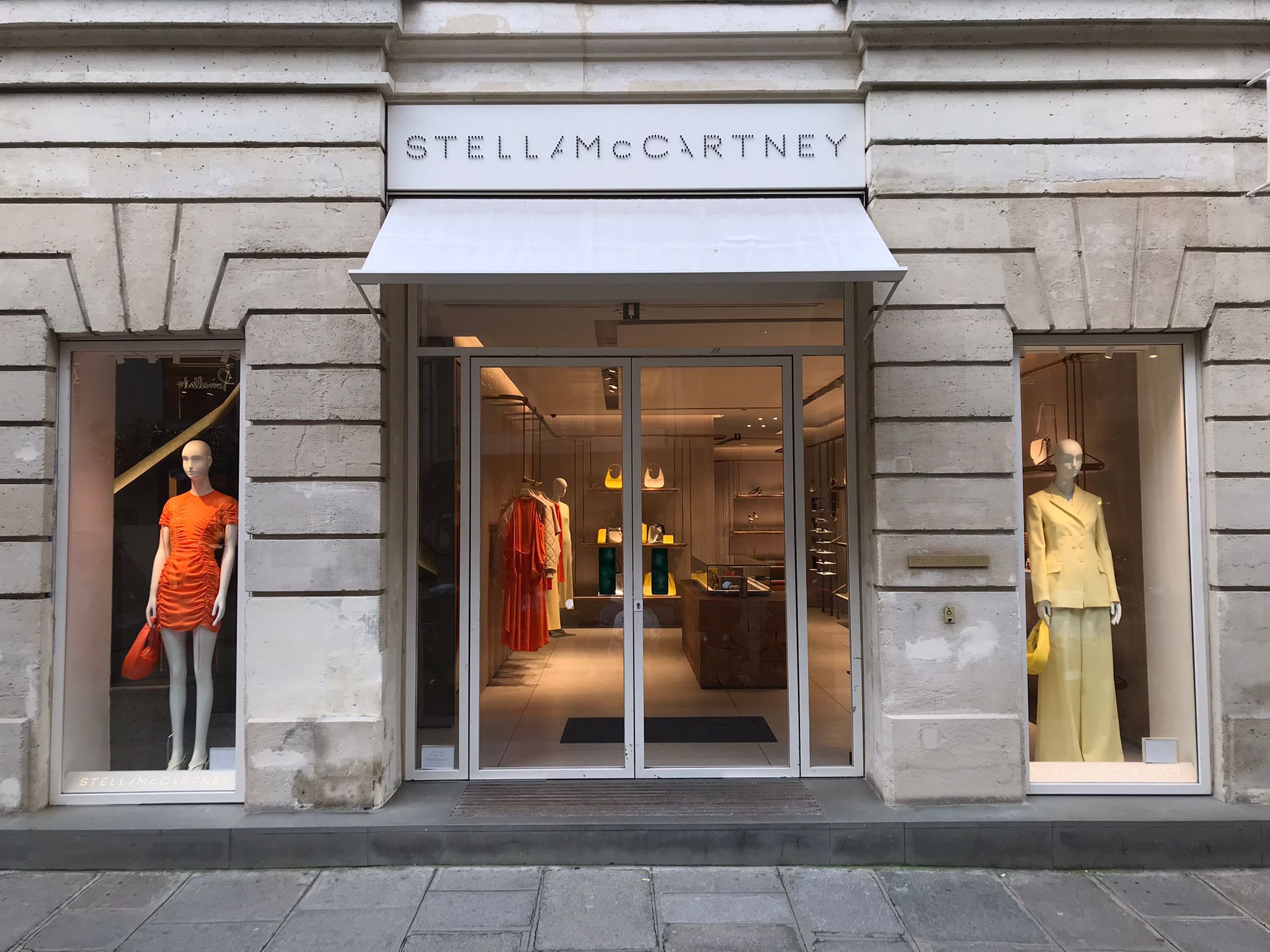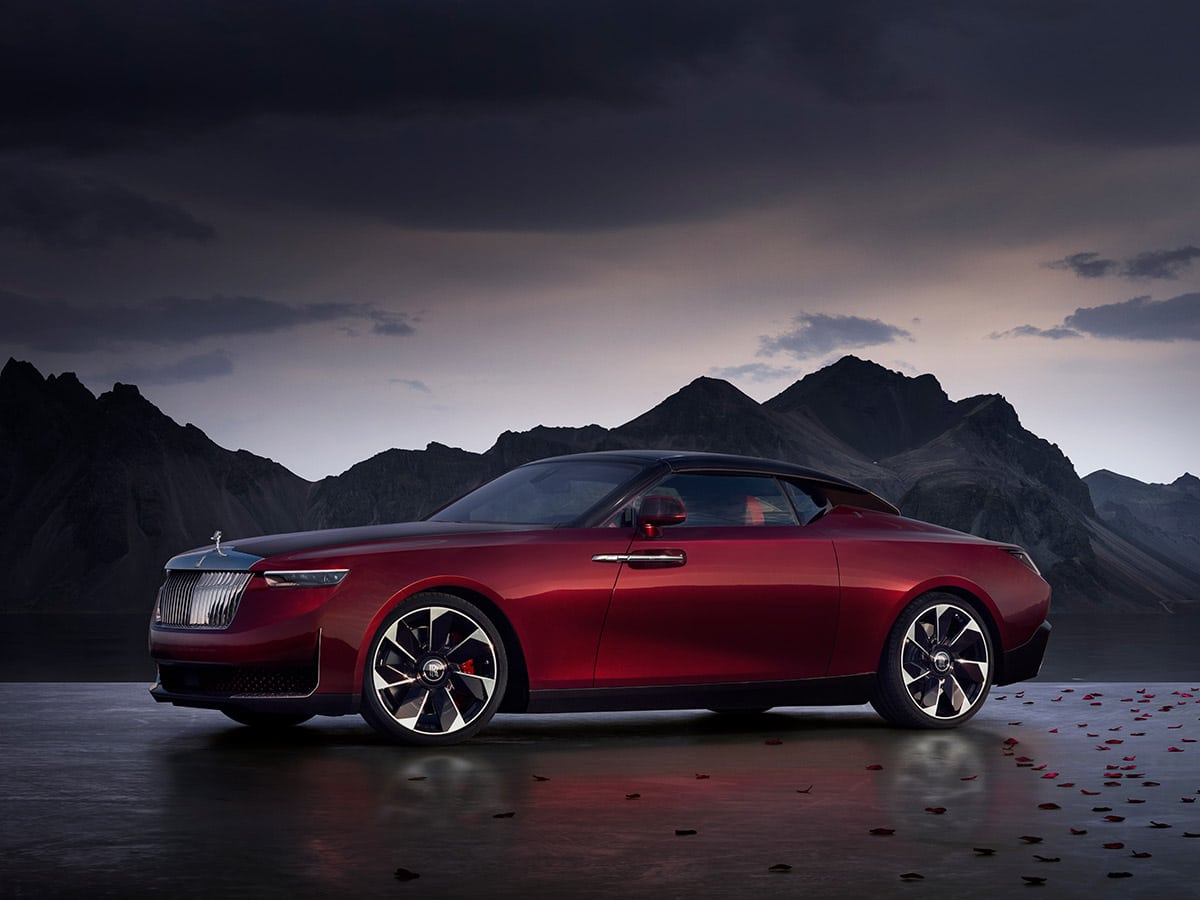[vc_row njt-role=”people-in-the-roles” njt-role-user-roles=”administrator,editor,author,armember”][vc_column][vc_column_text]
With the launch in August of a new collection of bags made from alternative materials, the House of Stella McCartney once again asserts its position as a leader in sustainable fashion. And with good reason: for some years now, the brand has been multiplying its partnerships to create products made exclusively from sustainable materials.
The Stella McCartney fashion house, founded by the eponymous designer, is a master of art and materials. The brand has just introduced its Falabella and Frayme bags, designed from Mirum, an alternative to leather. These are the world’s first luxury handbags made from this vegan, plastic-free material, developed by Natural Fiber Welding (NFW).
Made from all-natural, plant-based ingredients, Mirum also pioneers its category by being both 100% recyclable and circular. Stella McCartney claims it is “capable of being safely returned to Mother Earth in the form of nutrients at the end of its life”.
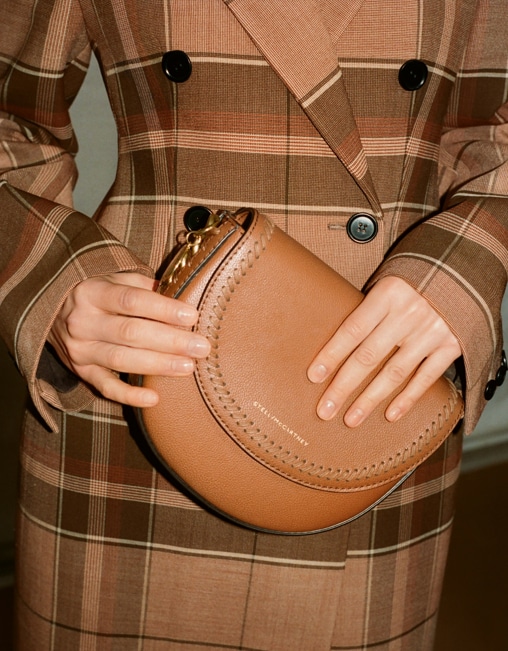
This material is manufactured in three stages from certified organic bioneutral ingredients, including natural rubber, natural fibers, plant-based oil and pigments such as biochar and rust. It contains no plastic and requires no tanning process or additional water to avoid wastewater generation.
Its carbon footprint is significantly lower than that of conventional options, whether of animal or synthetic origin. According to a life-cycle assessment study commissioned by NFW, Mirum generates between 0.8 and 2.1 kg of CO2 equivalent per square meter. In comparison, petroleum-based leather alternatives produce between 7 and 15.8 kg of CO2 equivalent.
Products made from Mirum are renowned for their suppleness and durability. They are also easy to clean and fully water-resistant.
A committed company
Stella McCartney is an exemplary example of what it means to be an ethically focused brand. From its very beginnings, the company has subscribed to ethical values and has consistently made a strong statement about the impact of its activities on the environment. And the brand is constantly striving to discover innovative ways of increasing its sustainability.
“I’ve long dreamed of the day when we’d see a plant-based leather alternative that doesn’t kill any creatures and can be easily returned to Mother Earth, without creating waste,” said the designer. “There are no compromises in terms of desirability or sustainability; the future of fashion has arrived.”
The company referred to data from the Food and Agriculture Organization of the United Nations (FAO), which reveals that in 2020, 1.4 billion animal hides were used in global leather manufacturing. Tanning processes often involve the use and production of toxic chemicals and gases, such as chromium IV.
“In addition to contaminating water systems and threatening workers’ health, the industry harms the planet through land destruction,” she said. “Cattle farming for meat and leather products is responsible for 80% of Amazon deforestation (WWF), removing vital carbon sinks and reducing biodiversity.”
Recycled products
Positioned as a pioneer of sustainability in the fashion industry, Stella McCartney has collaborated with other brands, integrating them into sustainable initiatives. A prime example is the recent launch of its partnership with Adidas, where pieces are made from post-industrial and post-consumer waste, such as plastic bottles.
In addition, Stella McCartney has deployed various sustainability initiatives, relentlessly pursuing the improvement of its environmental impact, from its regenerative project to its collaboration with Greenpeace.
Use of vegetable-based leather
Further reinforcing its commitment to sustainability, Stella McCartney has been collaborating with Mycelian start-up Bolt Threads since 2017. In July 2022, the brand launched its Frayme Mylo bag, designed using a mushroom-based alternative to leather. Stella McCartney was the first to make the mycelium bag commercially viable, and aims to integrate the Mylo into its core range of bags from 2023.
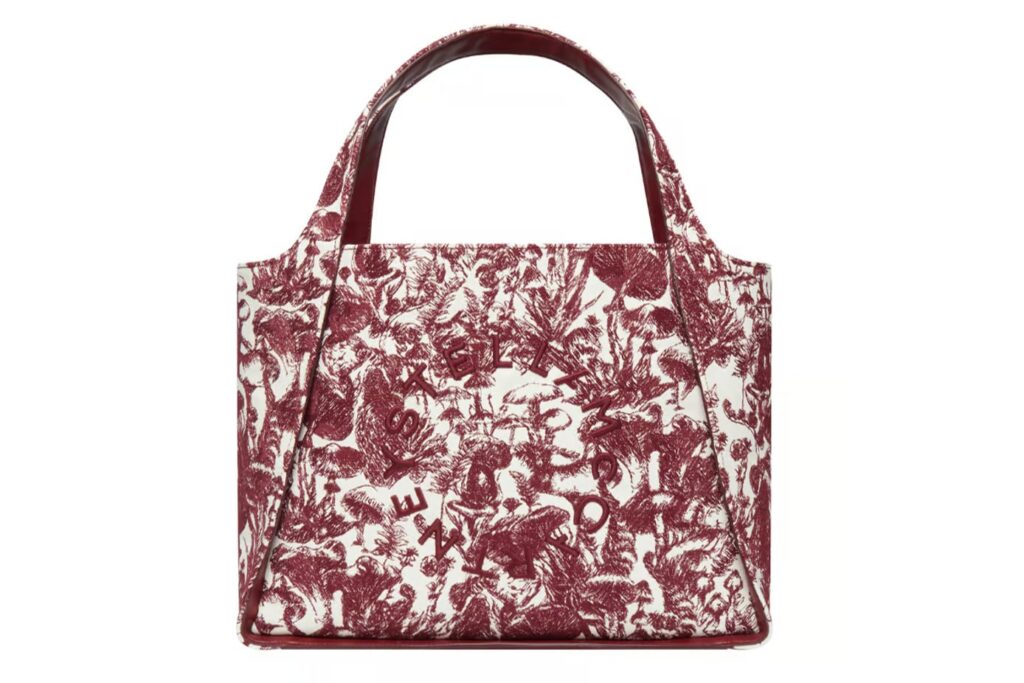
In the same spirit of developing environmentally-friendly materials, Stella McCartney teamed up with Bananatex last April. Bananatex is the world’s first biodegradable and vegan material innovation. This collaboration has led to the creation of a bag made from banana fibers. Bananatex is made exclusively from banana fibers grown organically in the highlands of the Philippines. It represents the world’s very first technical fabric made entirely from 100% of this raw material, and is plastic-free, making it an entirely regenerative material.
Featured photo : © Stella McCartney [/vc_column_text][/vc_column][/vc_row][vc_row njt-role=”not-logged-in”][vc_column][vc_column_text]
With the launch in August of a new collection of bags made from alternative materials, the House of Stella McCartney once again asserts its position as a leader in sustainable fashion. And with good reason: for some years now, the brand has been multiplying its partnerships to create products made exclusively from sustainable materials.
The Stella McCartney fashion house, founded by the eponymous designer, is a master of art and materials. The brand has just introduced its Falabella and Frayme bags, designed from Mirum, an alternative to leather. These are the world’s first luxury handbags made from this vegan, plastic-free material, developed by Natural Fiber Welding (NFW).
Made from all-natural, plant-based ingredients, Mirum also pioneers its category by being both 100% recyclable and circular. Stella McCartney claims it is “capable of being safely returned to Mother Earth in the form of nutrients at the end of its life”.

This material is manufactured in three stages from certified organic bioneutral ingredients, including natural rubber, natural fibers, plant-based oil and pigments such as biochar and rust. It contains no plastic and requires no tanning process or additional water to avoid wastewater generation.
Its carbon footprint is significantly lower than that of conventional options, whether of animal or synthetic origin. According to a life-cycle assessment study commissioned by NFW, Mirum generates between 0.8 and 2.1 kg of CO2 equivalent per square meter. In comparison, petroleum-based leather alternatives produce between 7 and 15.8 kg of CO2 equivalent.
Products made from Mirum are renowned for their suppleness and durability. They are also easy to clean and fully water-resistant.
A committed company
Stella McCartney is an exemplary example of what it means to be an ethically focused brand. From its very beginnings, the company has subscribed to ethical values and has consistently made a strong statement about the impact of its activities on the environment. And the brand is constantly striving to discover innovative ways of increasing its sustainability.
“I’ve long dreamed of the day when we’d see a plant-based leather alternative that doesn’t kill any creatures and can be easily returned to Mother Earth, without creating waste,” said the designer. “There are no compromises in terms of desirability or sustainability; the future of fashion has arrived.”
The company referred to data from the Food and Agriculture Organization of the United Nations (FAO), which reveals that in 2020, 1.4 billion animal hides were used in global leather manufacturing. Tanning processes often involve the use and production of toxic chemicals and gases, such as chromium IV.
[…][/vc_column_text][vc_cta h2=”This article is reserved for subscribers.” h2_font_container=”tag:h2|font_size:16|text_align:left” h2_use_theme_fonts=”yes” h4=”Subscribe now !” h4_font_container=”tag:h2|font_size:32|text_align:left|line_height:bas” h4_use_theme_fonts=”yes” txt_align=”center” color=”black” add_button=”right” btn_title=”I SUBSCRIBE !” btn_color=”danger” btn_size=”lg” btn_align=”center” use_custom_fonts_h2=”true” use_custom_fonts_h4=”true” btn_button_block=”true” btn_custom_onclick=”true” btn_link=”url:https%3A%2F%2Fluxus-plus.com%2Fen%2Fsubscriptions-and-newsletter-special-offer-valid-until-september-30-2020-2-2%2F”]Get unlimited access to all articles and live a new reading experience, preview contents, exclusive newsletters…
Already have an account ? Please log in.
[/vc_cta][vc_column_text]Featured photo : © Stella McCartney[/vc_column_text][/vc_column][/vc_row][vc_row njt-role=”people-in-the-roles” njt-role-user-roles=”subscriber,customer”][vc_column][vc_column_text]
With the launch in August of a new collection of bags made from alternative materials, the House of Stella McCartney once again asserts its position as a leader in sustainable fashion. And with good reason: for some years now, the brand has been multiplying its partnerships to create products made exclusively from sustainable materials.
The Stella McCartney fashion house, founded by the eponymous designer, is a master of art and materials. The brand has just introduced its Falabella and Frayme bags, designed from Mirum, an alternative to leather. These are the world’s first luxury handbags made from this vegan, plastic-free material, developed by Natural Fiber Welding (NFW).
Made from all-natural, plant-based ingredients, Mirum also pioneers its category by being both 100% recyclable and circular. Stella McCartney claims it is “capable of being safely returned to Mother Earth in the form of nutrients at the end of its life”.

This material is manufactured in three stages from certified organic bioneutral ingredients, including natural rubber, natural fibers, plant-based oil and pigments such as biochar and rust. It contains no plastic and requires no tanning process or additional water to avoid wastewater generation.
Its carbon footprint is significantly lower than that of conventional options, whether of animal or synthetic origin. According to a life-cycle assessment study commissioned by NFW, Mirum generates between 0.8 and 2.1 kg of CO2 equivalent per square meter. In comparison, petroleum-based leather alternatives produce between 7 and 15.8 kg of CO2 equivalent.
Products made from Mirum are renowned for their suppleness and durability. They are also easy to clean and fully water-resistant.
A committed company
Stella McCartney is an exemplary example of what it means to be an ethically focused brand. From its very beginnings, the company has subscribed to ethical values and has consistently made a strong statement about the impact of its activities on the environment. And the brand is constantly striving to discover innovative ways of increasing its sustainability.
“I’ve long dreamed of the day when we’d see a plant-based leather alternative that doesn’t kill any creatures and can be easily returned to Mother Earth, without creating waste,” said the designer. “There are no compromises in terms of desirability or sustainability; the future of fashion has arrived.”
The company referred to data from the Food and Agriculture Organization of the United Nations (FAO), which reveals that in 2020, 1.4 billion animal hides were used in global leather manufacturing. Tanning processes often involve the use and production of toxic chemicals and gases, such as chromium IV.
[…][/vc_column_text][vc_cta h2=”This article is reserved for subscribers.” h2_font_container=”tag:h2|font_size:16|text_align:left” h2_use_theme_fonts=”yes” h4=”Subscribe now !” h4_font_container=”tag:h2|font_size:32|text_align:left|line_height:bas” h4_use_theme_fonts=”yes” txt_align=”center” color=”black” add_button=”right” btn_title=”I SUBSCRIBE !” btn_color=”danger” btn_size=”lg” btn_align=”center” use_custom_fonts_h2=”true” use_custom_fonts_h4=”true” btn_button_block=”true” btn_custom_onclick=”true” btn_link=”url:https%3A%2F%2Fluxus-plus.com%2Fen%2Fsubscriptions-and-newsletter-special-offer-valid-until-september-30-2020-2-2%2F”]Get unlimited access to all articles and live a new reading experience, preview contents, exclusive newsletters…
Already have an account ? Please log in.
[/vc_cta][vc_column_text]Featured photo : © Stella McCartney[/vc_column_text][/vc_column][/vc_row]

